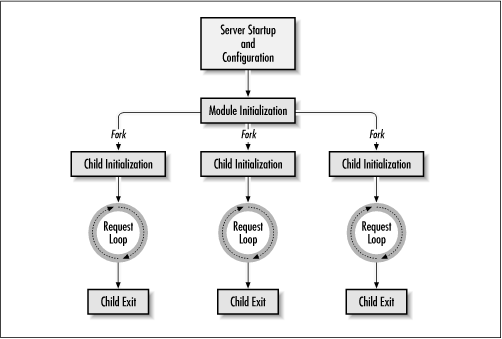3.2. The Apache Life Cycle
Apache's life cycle is straightforward (Figure 3.2). It starts up, initializes, forks off several copies of itself (on Unix systems only), and then enters a loop in which it processes incoming requests. When it is done, Apache exits the loop and shuts itself down. Most of the interesting stuff happens within the request loop, but both Perl and C-language modules can intervene at other stages as well. They do so by registering short code routines called "handlers" that Apache calls at the appropriate moment.[4] A phase may have several handlers registered for it, a single handler, or none at all. If multiple modules have registered their interest in handling the same phase, Apache will call them in the reverse order in which they registered. This in turn will depend on the order in which the modules were loaded, either at compile time or at runtime when Apache processes its LoadModule directives. If no module handlers are registered for a phase, it will be handled by a default routine in the Apache core.
[4] The Apache documentation sometimes refers to handlers as "hooks" or "callbacks," but don't worry, they're all the same thing.
Figure 3.2. The Apache server life cycle

3.2.1. Server Startup and Configuration
When the server is started, Apache initializes globals and other internal resources and parses out its command-line arguments. It then locates ...
Get Writing Apache Modules with Perl and C now with the O’Reilly learning platform.
O’Reilly members experience books, live events, courses curated by job role, and more from O’Reilly and nearly 200 top publishers.

